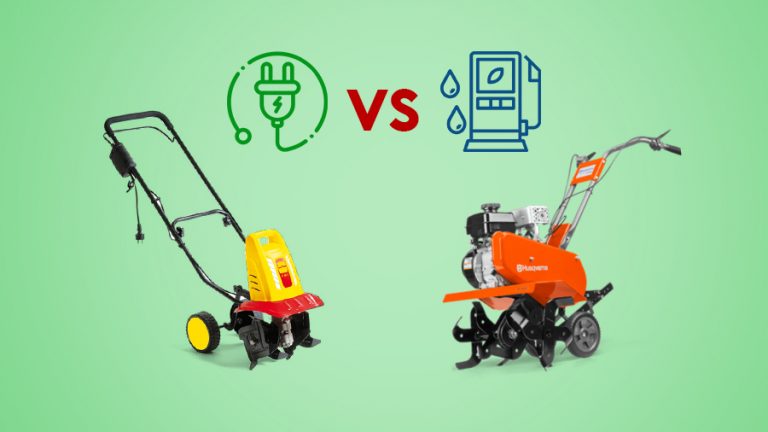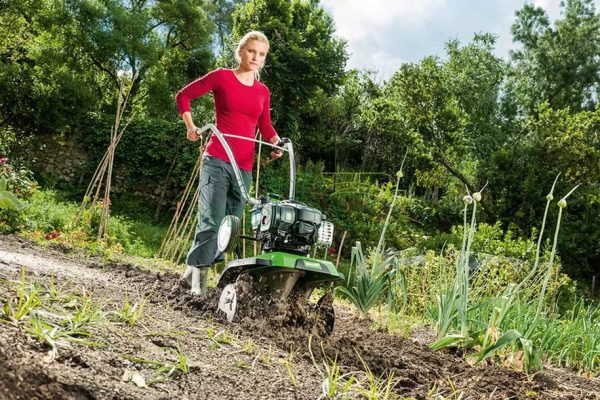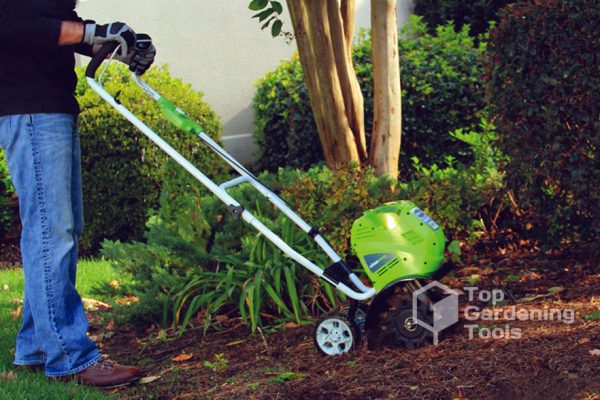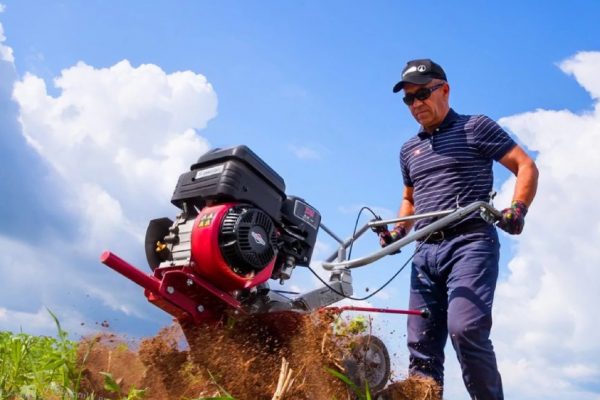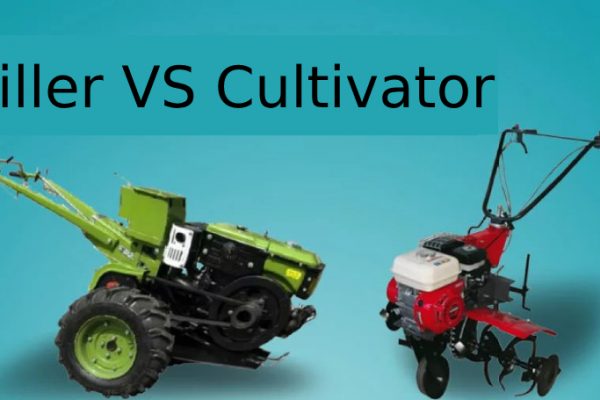Loosening (cultivation) of soil is a required procedure for the normal growth and development of plants. This process occurs by grinding the upper soil level. As a result, air and moisture penetrate better into the soil which contributes to the natural formation processes of the fertile layer. Sa a rule, these operations are performed using special equipment – gas powered cultivators/tillers.
Electric-powered cultivators are becoming more and more popular nowadays. Their distinctive feature is low weight, easy maintenance and absence of harmful emissions into the atmosphere. Compact size makes electro-powered cultivators an excellent device for small area works in the garden: weeding, loosening soil in the flower beds and greenhouses, cultivation area around trees.
Quick Picks: 4 Best Electric Tillers
- Mantis 7250-00-03 – Editor’s Choice. Best lightest small cultivator.
- Sun Joe TJ604E – Also great a powerful electric cultivator.
- BLACK+DECKER LGC120 – Best battery-powered cultivator for garden beds and weeding.
- Greenworks 27062 – Best battery-powered powerful electric tiller.
Quick Picks: 3 Best Gas Powered Tillers
- Mantis 7924 – Editor’s Choice. Best 2-cycle front-tine tiller.
- Husqvarna TR317DE – Best rear-tine gas tiller. The most expensive model.
- Earthquake 20015 Versa – Best front-tine 4-cycle tiller.
Fundamental differences
An internal combustion engine or electric engine can be used as the drive of the cultivator.
Noise
The disadvantage of the ICE is the high noise level. If the neighbours are not tolerant there is great risk that you will spend more time settling the conflict than processing the garden. So, what is the best choice electric or gas-powered cultivator – let’s try to find out.
Electric-powered cultivators
| Preview | Product | Type | Engine | Price |
|---|---|---|---|---|
 | Mantis 7250-00-03 Editor’s Choice | Front-Tine | Electric-powered 115V 540 watt 3-speed | $$$$ |
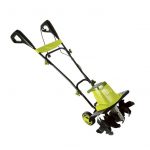 | Sun Joe TJ604E | Front-Tine | Electric-powered 13.5-amp motor | $ |
They are the most suitable option for gardeners who do not like the smell of gasoline, oil, and prefer simple to maintain units. The greatest advantage of electrically driven technology is silence and environmental friendliness. Due to the absence of exhaustion they can be used in greenhouses. Electric-powered cultivators are light-weighted and compact. This means that older people and tiny girls can operate them as well. Such dimensions allow them to be used in hard-to-reach areas of your site.
The main advantage is the lack of additional maintenance related to re-fueling and use of oils.
What are the disadvantages of the electric-powered cultivators?
The first thing that prevents many people from buying them is dependence on the power supply, what means that it is impossible to go further than the length of the extension cable. In this case you can consider the battery-powered cultivator.
The second drawback is low power. They are suitable for processing only previously cultivated ground but not for virgin lands.
Advantages:
- the price is lower than that of gasoline-powered ones;
- engine power range is from 0.6 kW to 5.5 kW;
- easy operation;
- it is possible to ploug the ground up to 250 mm deep;
- compact dementions;
- light weight;
- narrow and medium width gripping models.
Disadvantages:
- cable is required and the distance from the house is limited;
- when working, you need to be attentive not to break the cable;
- not possible to work in rainy weather;
- not suitable for large areas.
Battery-powered cultivators
| Preview | Product | Type | Engine | Price |
|---|---|---|---|---|
 | BLACK+DECKER LGC120 | Front-Tine | Battery-powered 20V lithium-ion battery | $ |
 | Greenworks 27062 | Front-Tine | Battery-powered 40V lithium-ion battery | $$$ |
Operate in the same way as electric-powered ones but have higher mobility due to the battery which should be recharged from time to time. They are distinguished by fully autonomous operation from the battery attached. They have a lightweight set convenient for use by women and elderly people. The absence of cable allows you not to think of extraneous things and completely focus on your favourite hobby.
Environmentally friendly and suitable for greenhouses or small beds next to the house in order not to use the extension cable every time.
Advantages:
- autonomous work;
- noiseless;
- exhaustion free;
- light-weight structure;
- convenient for use by elderly people and women;
- plowing depth is up to 200 mm;
- acceptable power;
- sufficient grip width of 260-300 mm.
Disadvantages:
- working hours are limited by battery capacity;
- the price is possible higher than that of electrical-powered ones;
- suitable only for small greenhouses or beds.
Tiller with internal combustion engine
Gas engine tillers are the most popular. They practically have no power limits.
Gas-powered tillers are more difficult to maintain. The engine should be cleaned from dust, ground residues and maintained from time to time. Neglecting this can lead to problems or even serious breakdowns. Due to exhaust emissions the device cannot be used in closed areas such as greenhouses.
Gas-powered tillers can be equipped with two types of internal combustion engines: four – stroke and two – stroke. In one case only gas is used, in the other case gas is mixed with oil which can be inconvenient during permanent use.
| Preview | Product | Type | Engine | Price |
|---|---|---|---|---|
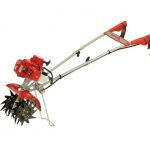 | Mantis 7924 Editor’s Choice | Front-Tine | Gas-powered 21.2cc 2-cycle | $$$$ |
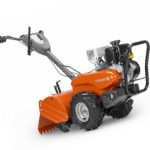 | Husqvarna TR317DE | Rear-Tine | Gas-powered 208cc 4-cycle | $$$$$+ |
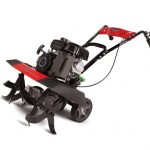 | Earthquake 20015 Versa | Front-Tine | Gas-powered 99cc 4-Cycle | $$$ |
Two-Stroke Engines (2-Cycle)
They are cheaper and 60 — 70% more powerful than four-stroke analogues (with the same dimensions). But there are disadvantaged at the same time. The first one is economy — the engine consumes more fuel. The second one is reliability and resource. To avoid serious breakdowns you should use only high-quality fuel and oil. In addition, it is necessary to adhere to the recommended mixing proportions. Otherwise, the breakage will happen much earlier than anticipated. As for motor resource two-stroke engines always are not as good as four-stroke ones. By the way, the repair of “two-stroke” ones is usually quite expensive. Foe this reason the spoiled equipment is sent not to a workshop but to a dump. The owner goes to make a new purchase. This type of engine can be found only on light-weight tillers.
Four-stroke engines (4-Cycle)
Almost all new models are equipped with this engine. The first serious advantage compared to the previous option is increased comfort as there is no need to mix gas with oil. They can boast low noise level. The weight is also different. Four-stroke engines are heavier and this fact only improves the work of this machinery when plowing and loosening. The engine is distinguished by its “cleanliness”. There is much less harmful emissions from “four-stroke” one. And most importantly, the device with this engine will last longer. In addition, 4-stroke engines are characterized by efficient operation which is also an advantage.
Advantages of gas-powered engines:
- mobility
- reliability
- high power and productivity
- various parameters of plowing width;
- suitable for the development of virgin lands;
- chain reducer conveys rotation well;
- wide variety according to value;
- wheel position adjustment.
Disadvantages:
- permanent maintenance;
- loud sound;
- gas and oil expences;
- heavy weight;
- emission into the atmosphere which is unacceptable in a greenhouse.
To sum up, I would like to say that whatever the tiller is gas or electric-powered one you will become the owner of universal and reliable equipment which can perform most of your gardening work.

